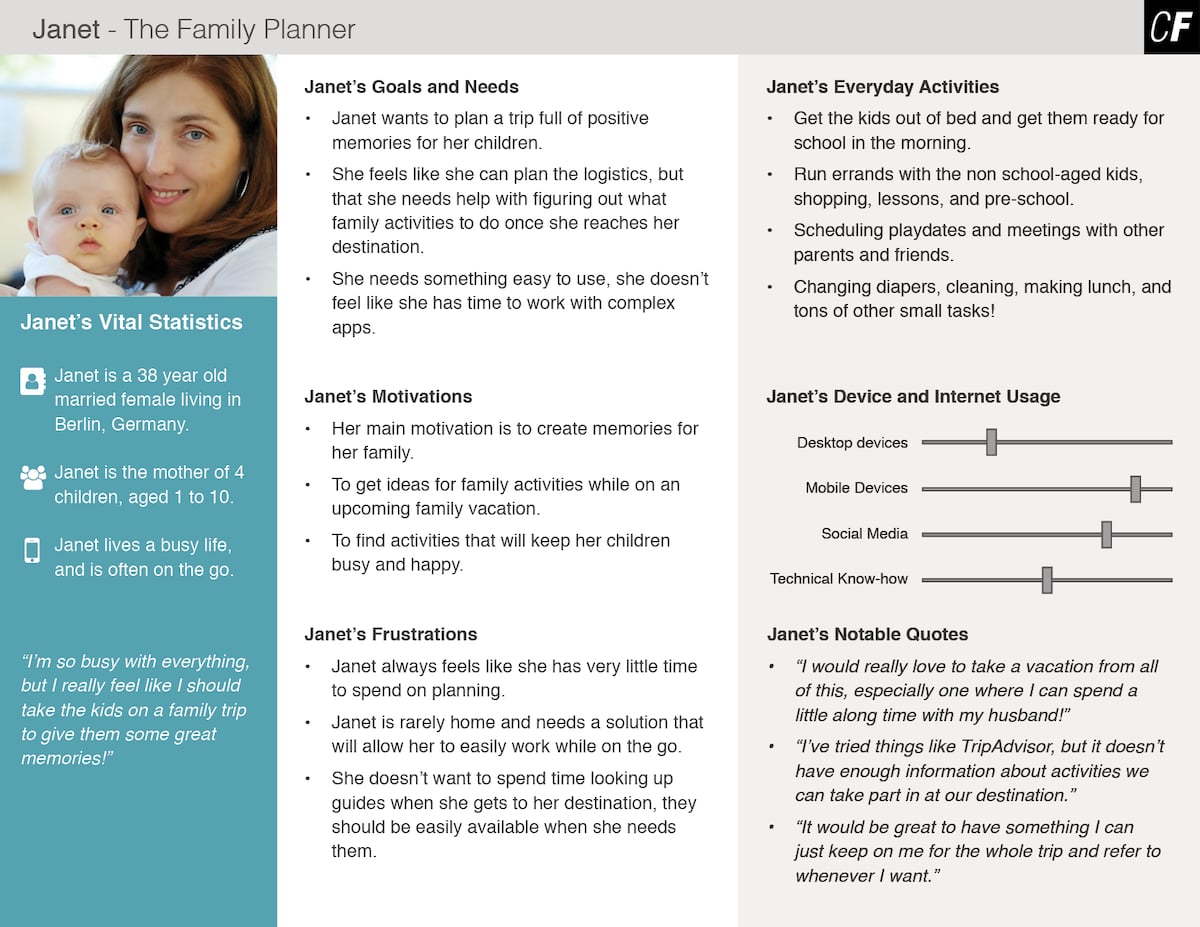2020-03-24 Data from CareerFoundry
什么是用户画像?What Is A User Persona?
用户角色是目标客户的虚构表现。作为一名 UX 设计师,你将通过进行用户研究来开始设计过程 — 与你的目标用户建立共鸣,并准确识别他们从你设计的产品中需要什么。角色通常基于用户研究,并包含目标受众的需求、目标和观察到的行为模式。查看以下示例:
A user persona is a fictional representation of your ideal customer. As a UX designer, you’ll start the design process by conducting user research—building empathy with your target users and identifying exactly what they need from the product you’re designing. A persona is generally based on this user research and incorporates the needs, goals, and observed behavior patterns of your target audience. Check out the example below:
为什么需要用户画像?-Why Do You Need A Persona?
无论您是在开发智能手机应用程序还是移动响应网站,了解谁将使用该产品都非常重要。为了解决一个真正的用户问题,你需要在头脑中有一个清晰的问题陈述; 为了写这个问题陈述,你首先需要了解你的用户和他们的需求。
了解您的受众将有助于影响您选择的功能和设计元素,从而使您的产品更有用。人物角色通过回答以下问题来陈述你的目标受众是谁:
1.谁是我的目标受众?
2.我的用户当前的行为模式是什么?
3.我的用户的需求和目标是什么?
4.在给定的背景下,他们目前面临哪些问题和痛点?
了解用户的需求对于开发成功的产品至关重要。定义良好的角色将使您能够有效地识别和传达用户需求。人物画像还将帮助您描述使用您产品的用户,这对您的整体价值主张至关重要。
人物画像有助于制定战略和做出明智的设计决策。他们让真正的用户铭记产品团队,有助于他们集中精力和建立情感共鸣。
因此,简而言之,如果你想设计对你的目标受众有用、可取和有价值的东西,用户画像是至关重要的。坚实的用户画像是你的明灯,从头到尾指导你的设计决策。
不仅如此。大多数设计师在多学科团队中工作,在这些团队中,从用户研究阶段传达您的发现是很重要的。人物角色包含了关于你的用户的所有基本细节,以一种每个人都能理解的令人难忘的方式呈现它们 — 不仅仅是设计师。
Whether you’re developing a smartphone app or a mobile-responsive website, it’s very important to understand who will be using the product. In order to solve a real user problem, you need to have a clear problem statement in mind; in order to write this problem statement, you first need to understand your users and their needs.
Knowing your audience will help influence the features and design elements you choose, thus making your product more useful. A persona clarifies who is in your target audience by answering the following questions:
- Who is my ideal customer?
- What are the current behavior patterns of my users?
- What are the needs and goals of my users?
- What issues and pain-points do they currently face within the given context?
Understanding the needs of your users is vital to developing a successful product. Well-defined personas will enable you to efficiently identify and communicate user needs. Personas will also help you describe the individuals who use your product, which is essential to your overall value proposition.
Personas help with strategizing and making smart design decisions. They make real users memorable for the product team, helping to focus efforts and build empathy.
So, in a nutshell, user personas are crucial if you want to design something that is useful, desirable, and valuable to your target audience. A solid user persona is your northern star, guiding your design decisions from start to finish.
Not only that. Most designers work in multidisciplinary teams where it’s important to communicate your findings from the user research stage. Personas encompass all the essential details about your users, presenting them in a memorable way that everyone can understand—not just designers.
如何绘制用户画像?-How Do You Define A User Persona?
在创建角色之前,请进行大量研究,以确保您的画像准确地代表您的用户。在你收集了足够数量的定性和定量数据后,将信息组织成代表你理想客户的角色。记住要专注于最重要的用户群体的主要需求 — 你不能为每个人的一切所设计,也不应该让用户画像成为每个人!
一旦你有了你的用户群组,你就可以把它们变成用户画像。让我们来看看创建用户角色的四个步骤。
A well-defined user persona contains four key pieces of information:
- Header
- Demographic Profile
- End Goal(s)
- Scenario
Before you create a persona, conduct plenty of research to make sure your personas accurately represent your users. After you gath**er **an adequate amount of both qualitative and quantitative data, organize the information into persona groups that represent your ideal customers. Remember to focus on the major needs of the most important user groups—you can’t be everything to everyone, nor should you try to be!
Once you’ve got your user groups, you can turn them into user personas. Let’s take a look at the four steps that go into creating a user persona.
Step 1: 添加一个用户名称-Add A Header
Header包括一个虚构的姓名、用户图片和用户特性。
这些功能有助于提高可记忆性,让您的设计团队专注于他们正在构建产品的用户。
让我们想象你正在设计一个旅行应用。您的用户角色可能如下所示:
姓名: 萨瓦娜 · 罗德里格斯
用户需求宣言: “带我去未被发现的度假目的地,远离旅游陷阱。”
这第一步可能看起来很简单,但是这些特性确保了你的角色令人难忘,让设计团队专注于他们为谁设计。
The header includes a fictional name, image, and quote that summarizes what matters most to the persona as it relates to your product. These features aid in improving memorability, keeping your design team focused on the users they are building the product for.
Let’s imagine you’re designing a travel app. The foundations of your user persona could look like this:
Name: Savannah Rodriguez
Summary quote: “Take me to undiscovered holiday destinations away from the tourist traps.”
This first step might seem simple, but these features ensure that your persona is memorable, keeping the design team focused on who they are designing for.
Step 2: 添加用户数据-Add A Demographic Profile
虽然名称和图像可能是虚构的,但统计数据是真实的,基于用户研究。
用户数据包括四个主要部分: 个人背景、专业背景、用户环境和心理
While the name and image can be fictional, demographic details are factual and based on user research. The demographic profile includes four main sections: personal background, professional background, user environment, and psychographics.
个人背景-Personal Background
个人背景包括年龄、性别、种族、教育、角色群等细节
(例如 g.工作妈妈) 和家庭状况 (例如 g.单身,已婚有孩子,丧偶等)。
萨瓦娜的个人背景可以这样描述:
萨瓦娜,52 岁,离婚的两个孩子的母亲,拥有化学硕士学位。
The personal background includes details such as age, gender, ethnicity, education, persona group (e.g. working moms), and family status (e.g. single, married with children, widowed, etc.).
Savannah’s personal background might be described as follows: Savannah, 52 years old, divorced mother of two, has a Master’s degree in chemistry.
专业背景-Professional Background
专业背景包括工作职业、收入水平和工作经验等细节。
萨瓦娜在一家制药公司全职工作,年收入约为 65,000 美元。
The professional background includes details such as job occupation, income level, and work experience. Here we might add that Savannah works full-time at a pharmaceuticals company and earns around $65,000 per year.
用户使用环境-User Environment
用户环境代表用户的物理、社会和技术环境。本节用于回答以下问题: 用户可以访问哪些技术设备?他们大部分时间是在公司办公室还是在家办公?他们多久与他人合作一次?
因此,萨瓦娜的用户环境可能在她的办公室里,主要是在笔记本电脑上,但在上下班的路上,也可能在她的 iPad 上。(平台:笔记本电脑/ipad)
The user environment represents the physical, social, and technological context of the user. This section is used to answer questions like: What technological devices do users have access to? Do they spend most of their time in a corporate office or a home office? And how often do they collaborate with others? So, Savannah’s user environment could be in her office, mostly on a laptop, but also on her iPad when commuting to and from work.
用户心理-Psychographics
心理图形包括态度、兴趣、动机和痛点等细节。创建一个心理档案可以让你更好地理解为什么你的用户以某种方式行事 — 包括他们为什么使用你的产品。
让我们继续想象你正在设计一个假日预订应用程序。用户角色中包含的一些有用的心理信息可能是:
萨瓦娜享受豪华水疗中心,讨厌旅游陷阱
她欣赏那些小众的,昂贵的或者是精心制作的,不为大众所知的。(exclusivity)
喜欢尝试当地传统美食
喜欢单独或与其他人同好一起旅行
倾向于旅行的质量而不是经济因素
总体而言,用户数据描述为用户画像添加了额外现实的因素,在探索用户需求和目标时增强了同理心。
Psychographics include details such as attitudes, interests, motivations, and pain points. Creating a psychographic profile enables you to better understand why your user behaves in a certain way—including why they use your product.
Let’s continue to imagine you’re designing a holiday-booking app. Some useful psychographic information to include in your user persona could be:
- Savannah enjoys luxury spa retreats, hates tourist traps
- Appreciates an element of exclusivity
- Enjoys trying authentic local cuisine
- Prefers to travel alone or with one other person
- Tends to favour quality over economy
Overall, the demographic profile adds an additional layer of realism to a user persona, boosting empathy when exploring user needs and goals.
Step 3: 添加最终目标-Add End Goal(s)
最终目标是激发用户行动的触点(motivating factor),并回答了以下问题: 用户希望或需要通过使用您的产品来实现什么?最终目标是用户的主要驱动力,并决定用户想要或需要实现什么。
就萨瓦娜而言,她在使用假日预订应用程序时的最终目标是发现和预订豪华的、优质小众的度假目的地。
The end goal is the motivating factor that inspires action, and answers the question: what do users want or need to accomplish by using your product? End goals are the main driving forces of your users and determine what the persona wants or needs to fulfill.
In Savannah’s case, her end goal when using your holiday-booking app is to discover and book luxurious, off-the-beaten-track holiday destinations.
Step 4: 添加一个场景-Add A Scenario
场景是一个 “生活中的一天” 的叙述,类似于用户旅程,描述了角色如何在特定的环境中与你的产品互动以实现他或她的最终目标。场景通常定义叙述发生的时间、地点和方式。它们通常是从人物角色的角度编写的,并描述将来可能发生的用例。
例如,萨瓦娜的场景可以这样开始:
“至少一年一次,我喜欢去一个豪华的假期。我试图发现我从未去过的地方,并坚持去那些还没有被游客淹没的目的地。我全职工作,所以我没有那么多时间浏览和预订我假期的每一个元素。理想情况下,我会找到一些当地餐馆推荐的套餐……”
A scenario is a “day-in-the-life” narrative that describes how a persona would interact with your product in a particular context to achieve his or her end goal(s). The scenario usually defines when, where, and how the narrative takes place. They are typically written from the perspective of the persona and describe use cases that may happen in the future.
For example, Savannah’s scenario could start off like this:
“At least once a year, I like to go away on a luxury holiday. I try to discover places I’ve never been to before, and to stick to destinations that aren’t yet overrun with tourists. I work full time, so I don’t have that much time to browse and book each individual element of my holiday. Ideally, I’ll find some kind of package deal that comes with local restaurant recommendations…”
额外的建议-Additional Suggestions
每个用户角色通常是一个页面,这需要你专注于基本元素。根据经验,避免添加不能用于影响设计的额外细节。如果它不影响最终设计或帮助更容易做出任何决定: 省略它。
人物角色也是在现实生活中寻找理想客户的关键,因此您可以与真实的人一起测试和验证您的产品。因此,确保每个角色都是具体和现实的: 避免夸张的漫画,并包含足够的细节来帮助你找到现实生活中的表现。
Each user persona is typically one page, which requires you to focus on the essential elements. As a rule of thumb, avoid adding extra details that cannot be used to influence the design. If it does not affect the final design or help make any decisions easier: omit it.
Personas are also key to finding ideal customers in real life so you can test and validate your product with real people. Therefore, make sure each persona is specific and realistic: avoid exaggerated caricatures, and include enough detail to help you find real-life representation.
总结-Conclusion
为了响应更短的项目节点,人物画像是快速识别用户需求的首选方法。通过使用真实数据来开发原型用户,团队可以为人物角色设计,并相信他们也将满足更广泛的消费者群体的需求。
创建用户角色时,请记住关注您正在设计的产品的背景。虽然你确实想建立一个现实的角色,但没有必要包括不会影响最终设计的无意义的细节。如果你正在设计一个假日预订应用程序,那么包含萨瓦娜最喜欢的电视节目或她支持的足球队的信息是没有意义的。所以,只包括服务于设计目的的细节!
总的来说,角色在整个产品开发阶段都是有帮助的: 从决定原型中的哪些功能,到评估最终产品。当与其他用户体验设计方法 (如可用性测试和任务分析) 相结合时,人物角色对于启动有用且可用的解决方案至关重要。
In response to shorter project timelines, personas are the go-to method for rapidly identifying user needs. By using real data to develop archetypical users, teams can design for personas with the confidence that they will also meet the needs of the broader consumer base.
When creating user personas, remember to focus on the context of the product you’re designing. While you do want to build up a realistic character, there’s no need to include pointless details that won’t influence the final design. If you’re designing a holiday-booking app, it doesn’t make sense to include information on Savannah’s favourite TV programs or what football team she supports. So, only include details that serve a design purpose!
Overall, personas are helpful throughout the entire product development phase: from deciding on which features to have in a prototype, to evaluating the end product. When combined with additional user experience design methods, such as usability testing and task analyses, personas are vital to launching a useful and usable solution.
感谢您的阅读
翻译和整理 by 嘉艺
2020.03.23
如有任何疑问或机会请发送邮件至email:
[_lucida997@outlook.com]()



